Eight auspicious symbols: Difference between revisions
No edit summary |
RyanJacobson (talk | contribs) mNo edit summary |
||
| (17 intermediate revisions by 2 users not shown) | |||
| Line 1: | Line 1: | ||
The ''' | The '''eight auspicious symbols''' (Skt. ''aṣṭamaṅgala''; Tib. བཀྲ་ཤིས་རྟགས་བརྒྱད་, ''tashi takgyé'', [[Wyl.]] ''bkra shis rtags brgyad'') are: | ||
| Line 7: | Line 7: | ||
| | | | ||
===The Most Precious Parasol=== | ===The Most Precious Parasol=== | ||
* sitātapatra | *(Skt. ''sitātapatra''; Tib, གདུགས་, Wyl. ''gdugs'') | ||
Protects from suffering, [[destructive emotions]], illness, harm and obstacles. | Protects from suffering, [[destructive emotions]], illness, harm and obstacles. | ||
|- | |- | ||
| [[Image:Fish1.JPG]] | | [[Image:Fish1.JPG]] | ||
| | | | ||
===The Auspicious Golden Fishes=== | ===The Auspicious Golden Fishes=== | ||
* | *(Skt. ''kanakamatsya''; Tib. གསེར་ཉ་, Wyl. ''gser nya'') | ||
They stand for fearlessness, freedom and liberation, as well as happiness, fertility and abundance. | They stand for fearlessness, freedom and liberation, as well as happiness, fertility and abundance. | ||
|- | |- | ||
| [[Image:Vase1.JPG]] | | [[Image:Vase1.JPG]] | ||
| | | | ||
===The Wish-fulfilling Vase of Treasure=== | ===The Wish-fulfilling Vase of Treasure=== | ||
* | *(Skt. ''nidhighaṭa''; Tib. བུམ་པ་, Wyl. ''bum pa'') | ||
An inexhaustible source of long life, wealth, and prosperity, which fulfils all one’s spiritual and material wishes. | An inexhaustible source of long life, wealth, and prosperity, which fulfils all one’s spiritual and material wishes. | ||
|- | |- | ||
| [[Image:Lotus1.JPG]] | | [[Image:Lotus1.JPG]] | ||
| | | | ||
===The Exquisite Lotus Blossom=== | ===The Exquisite Lotus Blossom=== | ||
* | *(Skt. ''padmakuñjara''; Tib, པད་མ་, Wyl. ''pad ma'') | ||
Stands for purity of mind and heart, and transformation, as well as compassion, and all perfect qualities. | Stands for purity of mind and heart, and transformation, as well as compassion, and all perfect qualities. | ||
|- | |- | ||
| [[Image:Conch1.JPG]] | | [[Image:Conch1.JPG]] | ||
| | | | ||
===The Conch Shell of Far Renown=== | ===The Conch Shell of Far Renown=== | ||
* | *(Skt. ''śaṅkhavarta''; Tib. དུང་དཀར་གཡས་འཁྱིལ་, Wyl. ''dung dkar g.yas 'khyil'') | ||
Symbolizes the far-reaching melodious sound of the spiritual teachings. | Symbolizes the far-reaching melodious sound of the spiritual teachings. | ||
|- | |- | ||
| [[Image:Knot1.JPG]] | | [[Image:Knot1.JPG]] | ||
| | | | ||
===The Glorious Endless Knot=== | ===The Glorious Endless Knot=== | ||
* | *(Skt. ''śrīvatsa''; Tib. དཔལ་བེའུ་, Wyl. ''dpal be'u'') | ||
The sign of interdependence, of how everything in the universe is interconnected. | The sign of interdependence, of how everything in the universe is interconnected. | ||
|- | |- | ||
| [[Image:Umbrella1.JPG]] | | [[Image:Umbrella1.JPG]] | ||
| | | | ||
===The Ever-Flying Banner of Victory=== | ===The Ever-Flying Banner of Victory=== | ||
* | *(Skt. ''kundadhvaja''; Tib. རྒྱལ་མཚན་, Wyl. ''rgyal mtshan'') | ||
Means victory over all disagreement, disharmony or obstacles, and the attainment of happiness, both temporary and ultimate. | Means victory over all disagreement, disharmony or obstacles, and the attainment of happiness, both temporary and ultimate. | ||
|- | |- | ||
| [[Image:Wheel1.JPG]] | | [[Image:Wheel1.JPG]] | ||
| | | | ||
===The All-powerful Wheel=== | ===The All-powerful Wheel=== | ||
* | *(Skt. ''suvarṅacakra''; Tib. ཆོས་ཀྱི་འཁོར་ལོ་, Wyl. ''chos kyi 'khor lo'') | ||
Symbolizes the teaching of Buddha, and is the source of spiritual values, wealth, love and liberation. | Symbolizes the teaching of Buddha, and is the source of spiritual values, wealth, love and liberation. | ||
|} | |} | ||
==Further Reading== | |||
*Dagyab Rinpoche, ''Buddhist Symbols in Tibetan Culture'' (Boston: Wisdom Publications, 1995), '1. The Eight Symbols of Good Fortune'. | |||
*Robert Beer, ''The Handbook of Tibetan Buddhist Symbols'' (Boston: Shambhala, 2003), pages 1-15. | |||
==Internal Links== | |||
*[[བཀྲ་ཤིས་]], ''tashi'', auspicious | |||
[[Category:Symbols]] | |||
[[Category:Enumerations]] | [[Category:Enumerations]] | ||
[[Category:08-Eight]] | |||
Latest revision as of 19:40, 2 July 2025
The eight auspicious symbols (Skt. aṣṭamaṅgala; Tib. བཀྲ་ཤིས་རྟགས་བརྒྱད་, tashi takgyé, Wyl. bkra shis rtags brgyad) are:
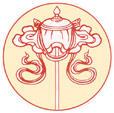
|
The Most Precious Parasol
Protects from suffering, destructive emotions, illness, harm and obstacles. |
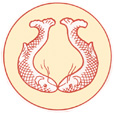
|
The Auspicious Golden Fishes
They stand for fearlessness, freedom and liberation, as well as happiness, fertility and abundance. |
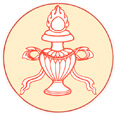
|
The Wish-fulfilling Vase of Treasure
An inexhaustible source of long life, wealth, and prosperity, which fulfils all one’s spiritual and material wishes. |
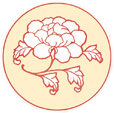
|
The Exquisite Lotus Blossom
Stands for purity of mind and heart, and transformation, as well as compassion, and all perfect qualities. |

|
The Conch Shell of Far Renown
Symbolizes the far-reaching melodious sound of the spiritual teachings. |
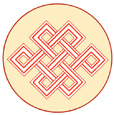
|
The Glorious Endless Knot
The sign of interdependence, of how everything in the universe is interconnected. |
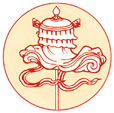
|
The Ever-Flying Banner of Victory
Means victory over all disagreement, disharmony or obstacles, and the attainment of happiness, both temporary and ultimate. |
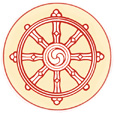
|
The All-powerful Wheel
Symbolizes the teaching of Buddha, and is the source of spiritual values, wealth, love and liberation. |
Further Reading
- Dagyab Rinpoche, Buddhist Symbols in Tibetan Culture (Boston: Wisdom Publications, 1995), '1. The Eight Symbols of Good Fortune'.
- Robert Beer, The Handbook of Tibetan Buddhist Symbols (Boston: Shambhala, 2003), pages 1-15.
Internal Links
- བཀྲ་ཤིས་, tashi, auspicious